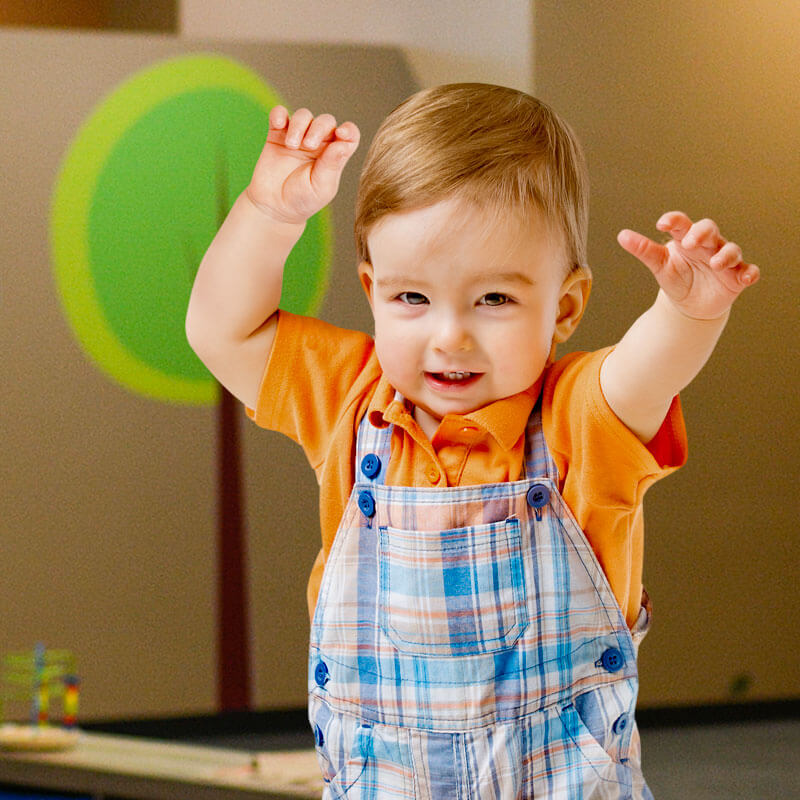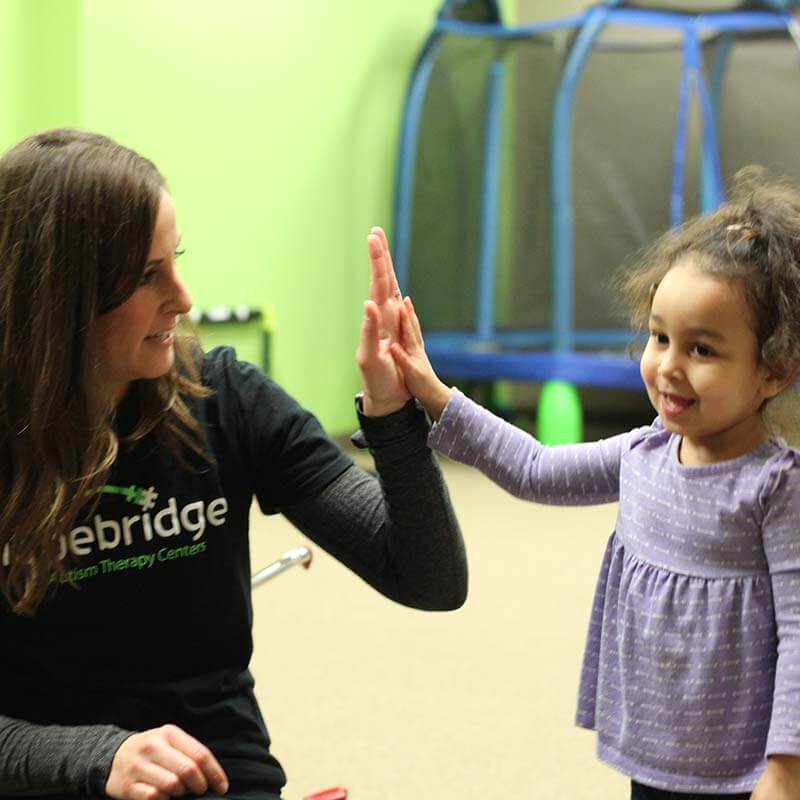My Child is Not Talking...Is it a Speech Delay or Autism?
October 04, 2019
October 04, 2019

Is your child a late talker? Since the timing of developmental milestones can vary, it can be tough to know if and when to intervene. Even when you do reach out for help, what type of intervention is best… does he or she need speech therapy or would your kid benefit from something more comprehensive?
Every child is different, but we have found many kids – especially those with autism spectrum disorder (ASD) – have a higher rate of success when we combine efforts, such as speech and language therapy alongside applied behavior analysis (ABA therapy).
To learn more about the advantages of integrating speech and ABA therapy, we turned to two of our Hopebridge heroes who experience them daily at the Carmel center in Indiana. Board Certified Behavior Analyst (BCBA) Amy Miller and Speech Language Pathologist (SLP) Amanda Sicking discuss what it is like to blend these two complementary services, how they support each other, and why it works.
When determining the best route for your family, there is not a one-size-fits-all answer. If you are not sure where to go, we recommend first sharing your concerns with the pediatrician. At this point, the physician may lead you down a couple of different routes. Some can lead to ABA, some speech, and many times to both. They will help you identify whether it is solely a speech delay or they will provide a referral for a deeper diagnostic evaluation. Many times, physicians will clump multiple evaluations together to make sure children are assessed for all of the services they may need.
Pediatricians often begin referring children for speech therapy around 18 to 24 months old, typically for expressive language if they are only speaking a few words. Parents may begin to notice a delay around 12 months if a child does not use more than one or two words, but they should have a much more extensive vocabulary by 24 months.

Parents may begin to notice a delay around 12 months if a child does not use more than one or two words.
Referrals for ABA therapy work a bit differently. While applied behavior analysis can be effective for a variety of scenarios, in many states, therapy requires an autism diagnosis. Because of this, to know whether your child is a good candidate for ABA therapy, you and your pediatrician should review the signs and symptoms of ASD and schedule a diagnostic assessment, if warranted. While deficits in communication are part of the criteria for autism, there are a number of other factors, including social challenges, repetitive and restrictive interests and behaviors, and sensory issues.
Once diagnosed with ASD, ABA can help the kiddo gain communication, social and adaptive living skills while decreasing as many maladaptive behaviors as possible. Challenges for those who are not yet school-aged may be trouble making eye contact, expressing themselves, following directions or engaging in tantrums. Those a little older may need assistance if they do not seem to benefit from a school environment or are struggling with many maladaptive behaviors in the community, home, school or daycare. In addition, if they do not seem to make friends as quickly or have a difficult time playing with toys effectively, they may experience an increased chance for success in a comprehensive therapy environment.
While communication is not the only challenge for some of the children we see, the root cause for many maladaptive behaviors is a lack of words, language skills or the ability to express emotions. A child who has a meltdown, runs off, flaps his hands or does not follow directions may be attempting to communicate something else entirely, either because he is nonverbal or unable to use words effectively in a social context. Because of this, complimentary services like speech and occupational therapy bleed into ABA pretty consistently.
Some of the benefits of a 360-degree approach like the Hopebridge model include:

ABA is wonderful, speech is wonderful, but they are so much better together.
For collaboration like this to occur, Amy and Amanda note that all parties involved must be flexible, open to feedback and support each other. This way, the children they treat can receive the best of both worlds. While all Hopebridge kiddos they work with are special to them, there are three cases when they felt their teamwork really shined.
The first is a 2-year-old who was referred to the center by his pediatrician for the full Hopebridge360 services of ABA, speech and occupational therapy. Amy remembers Amanda’s expertise in speech sounds helpful to her own ABA sessions with him. Not only did she provide techniques to teach the sounds of certain consonants and combinations, but also background on the developmental order of how they would be produced, of which BCBAs might not normally have specific content knowledge. In turn, Amy was able to provide her ABA perspective to Amanda regarding tantrums and help her understand what might tip him over the edge. She then lessened those scenarios during speech sessions until he was more comfortable with her pushing him a bit more each time. As a result, this kiddo achieved more variety in his language, was better understood and has fewer maladaptive behaviors during his sessions now that he is able to voice his wants and needs.
Another child came to Hopebridge for speech and occupational therapy, but did not have an autism diagnosis when he first arrived. Soon after starting outpatient services at the center, it was clear to Amanda there were more challenges, so she approached Amy for a second opinion. Neither are diagnosticians, but they both recognized the signs and symptoms typical of a child with autism, so they came together as a team. After one of Amanda’s speech sessions, Amy spoke to the mother about autism and ABA, and she was on board with getting a formal evaluation. Thanks to their collaboration, they were able to get this family the life-changing services they needed.
The third case that stands out involved a child who came to Hopebridge with a pretty significant medical history and serious feeding challenges. Not eating, vomiting multiple times a day, nonverbal and failure to thrive, Amy and Amanda worked together to get this kiddo the support he needed for a better life. Because ABA took up the majority of his time at Hopebridge – 40 hours a week – what he ate had a big impact on his services. In addition to working with her on speech, it was crucial that Amy incorporate Amanda’s expertise in feeding and swallowing to make decisions that would not be dangerous to his health. Amy spoke to gastrointestinal specialists, pediatricians, and dieticians, then combined efforts with Amanda on his program, parent training and overall progress. Within less than a year, this boy is tolerating more food, using phrases and sentences, greeting his parents and peers, and even requested a high five from a novel person in the center lobby, which is huge!
ABA is wonderful, speech is wonderful, but they are so much better together. To give your child the best chance to lead a fulfilling life, take advantage of the resources available to you. If your child is referred for one or the other, research your options to see if there is an opportunity for additional resources that may benefit your family.
While seeking the proper resources, there are a few additional things you can do to help your kiddo. Continue to talk to him or her and verbally label familiar items as much as possible within your environment. Have your child follow directions in a fun way. Combine short phrases together to talk about what you are doing and the actions you’re completing. By combining your interactions with other people – such as waving and saying “hi” – it shows your child what these mean and how to use them, especially if he or she is delayed in speech.
Above all, praise your kid and express excitement when they attempt to communicate with others, even if it does not come out correctly. It might be frustrating or difficult for them, so your enthusiasm will encourage them to become more engaged with others and willing to try it again.
If you are seeking the answers as to what is right for your child and family, reach out to us. We can talk you through the resources available at Hopebridge and walk you through the referral process for diagnoses or referrals, depending on where you are in your journey.
Autism Therapy
September 13, 2019
How do you Keep my Child Safe During Autism Therapy? Learn from a Hopebridge BCBA
Autism Therapy
July 29, 2024
Hopebridge Partners with EarliPoint Health to Provide Objective Autism Assessment for Babies and Toddlers
Autism Therapy
July 08, 2020
Hopebridge Autism Therapy Center Becomes Official ACE Provider